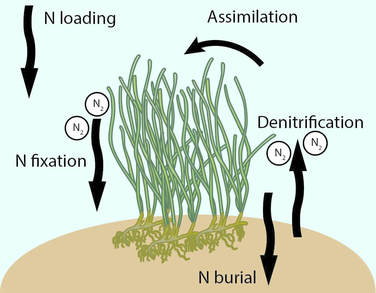Nitrogen cycling in seagrass meadows
|
A large-scale seagrass seeding project at the Virginia Coast Reserve Long-Term Ecological Research Site has lead to the establishment of over 25 square kilometers of restored seagrass meadow since 2001. A primary focus of my dissertation was to measure how this shift from a bare, unvegetated state to a mature seagrass meadow affected nitrogen cycling. To achieve this goal, I measured a suite of nitrogen transformations in the meadow, including denitrification, fixation, burial, and assimilation, to construct a nitrogen budget for the restored meadow. I also made analogous measurements in unvegetated sediments, in order to compare the seagrass meadow budget to a bare sediment budget. My data show that on an annual scale, the seagrass meadow is a net sink for reactive nitrogen, due in part to high rates of nitrogen burial in the sediments. In comparison, the bare sediment is a net source of nitrogen to the surrounding waters. The restored meadow thus acts as an important filter for nitrogen inputs to the coastal bays.
I have presented portions of this work at the CERF 2015, CERF 2017, and ASLO 2017 meetings. A comparison of denitrification and DNRA in the restored seagrass meadow and unvegetated sediments is published in Marine Ecology Progress Series here. A full comparison of the seagrass and bare sediment nitrogen processes is published in Limnology and Oceanography here. |


